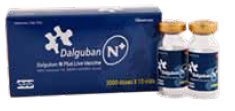Recent outbreaks of Newcatles disease in Asia is causing serious problem in poultry industry despite of rigid vaccination
program being implemented. Newcastles virus, a type 1 avian paramyxovirus (APMV-1),which cause Newcastles disease is listed
as one of notifiable disease by the World Organization for Animal Health (OIE).
From studies conducted by Maizan M et al (2001), Sheau Wei Tan et al.(2009), Ayalew Berhanu et al (2010) and unpublished studies from UPM on sequence and phylogenetic analysis of ND genotypes isolated in Malaysia from year 2000 to 2001; 2004 to
2005; and 2010 to 2013, isolates from different states showed that the highly virulent Genotype VII viruses were responsible for
outbreaks of ND in chicken flocks.
The virus is considered to be vvND with lesions like hemorrhages in the proventriculus, cecal tonsils,button ulcers in the intestine,
thymus gland atrophy among others. Mortality can be from 20% to 100% on highly infected flocks. Current outbreaks also occur
on early stage, the earliest is around 8 days to 17 days old. Below are the lesions found during the post-mortem done on some
farms that had a recent ND outbreak.

The focus of control measures are on vaccination and biosecurity, however, outbreaks occurred despite massive vaccination
programs (Sheau Wei Tan, et.al, 2009). As also shown in the work by Miller et al.(2010), the estimate of the
evolutionary divergence among genotypes showed the distance of Genotype VII among Genotype I and II are 13.3% and 18.1%
respectively. This demonstrates how wide the differences of viruses within existing heterologous vaccines and the field strain.In a
study done by Cho et al., (2007) the HI titers of the anti-La sota antiserum against La sota (Genotype II) and KBNP-4152 (Genotype
VII) were 256 and 32, and those of the anti-KBNP-4152 antiserum were 64 and 256. Cross HI and SN tests showed only 18% of cross
antigenic reaction (cross protection) between Lasota and KBNP-4152 (Genotype VIId). Cross protection on HI test was also
demonstrated by Rahman et al. (unpublished) wherein serum HI antibody response in commercial broiler following vaccination
indicating poor cross protection (cross antigenic reaction) between Genotype II and Genotype VII. Another study on Cross HI titer
between genotype II and genotype VII was demonstrated by Hu et al., 2009, wherein wide antigenic differences was observed
between La sota and NDV/ZJ HN (Genotype VII) in terms of cross HI tests. Homologous HI titres are better compared to
heterologous.
Various articles showed that when SPF chickens challenge with NDV Genotype VII inoculated intraocular or intranasal, Lasota
vaccine can protect SPF on survivability of 89% (Cho et al.) to 100% ( Hu et al., Bwala et al., Jeon et al.), Ulster & B1 vaccine also
can protect on survivability of 100%. (Jeon et al., Masaji et al.), but does not prevent the birds from morbidity and viral shedding
(transmission to healthy birds). However, when SPF birds challenge with NDV Genotype VII inoculated intramuscularly, Lasota and
Clone 30 could not protect from mortality with 0% survival rate Yi et al. (2008). The only trial done in commercial layers wherein
when challenged with NDV Genotype VII that was inoculated intraocular or intranasal, Genotype VII vaccinated group showed no
egg drop compared to those given with Lasota that has moderate to severe egg drop.In a local trial done by IBS,UPM broilers
were challenged with NDV Genotype VII inoculated intraocular, Genotype VII vaccinated group gives fully protection on broilers
with 0% mortality and 0% morbidity. However, Lasota vaccinated birds give partial protection with 20% morbidity and 13%
mortality.

In the effort to control ND outbreak,KBNP, Inc., developed Himmvac Dalguban N+ vaccine, a recombinant La sota strain in which fusion (F) and hemagglutinin-neuraminidase (HN) genes were replaced with those of contemporary genotype VIId virus. Himmvac Dalguban N+, a homologous vaccine, were completely protective against mortality and egg drop caused by virulent strain. N+ vaccine is 5.5 times better than conventional heterologous vaccine in terms of antigenicity,productivity,safety and pathogenic stability. Furthermore, using N+ vaccine as homologous to the virulent strain significantly reduce viral shedding , making Himmvac Dalguban N+ a promising vaccine,which can be the best solution for ND outbreaks in Malaysia.

DALGUBAN N+
Composition
Genotype VII ND virus (KBNP-C4152R2L strain) propagated in SPF chicken egg.
Indication
For vaccination of health chickens, as an aid in the preventing Newcastle disease.
Dosage and usage
A. Spray Vaccination Procedure
B. Intraocular Vaccination Procedure
C. Drinking Vaccination Procedure
Packing
2,000 doses
Storage condition
Protect from light and store at 2 to 8

